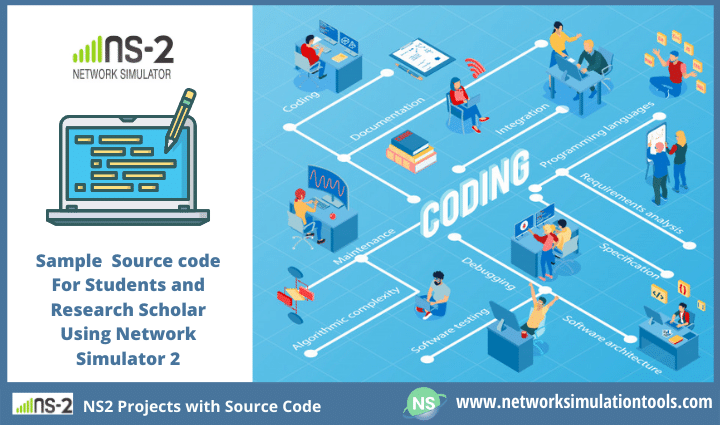Ns2 Projects with source code – NS2, abbreviated as Network Simulator 2, is a fundamental of the network simulation tool. In short, it’s an event network simulator tool that is highly used in research and development.Ns2 is developed at UC Berkeley. Ns2 Projects contains a rich library of network and protocol objects.
In which we are also going to discuss what is the languages to be used in ns2 projects as well as nam, graph details. Reach us, we provide ns2 projects with source code for research scholars from expert team.

Supporting Tools Utilized in Ns2 Projects: There also two supporting tools also used in ns2 projects for providing output.
# (1) Create the trace file
set namfile [open out.nam w]
# (2) Tell NS to write NAM network events to this trace file
$ns namtrace-all $namfile
# (3) Close output file at the end of the simulation run
proc finish {} {
global ns namfile
$ns flush-trace ;# flush trace files
close $namfile ;# close trace file
exec nam out.nam & ;# OPTIONAL: run NAM from inside the NS simulation
exit 0
}
XGraph is a plotting program that is used to create graphic representations of simulation results. It is important because it allows some basic animation of data sets. The animation only pages through data sets in the order in which they loaded. It is quite crude, but useful if all the data sets in one file in the time order and are put out at uniform intervals.
The following protocols also to the combination of proactive, reactive, hybrid, and clustering protocols,
| Technology | Ph.D | MS | M.Tech |
|---|---|---|---|
| NS2 | 75 | 117 | 95 |
| NS3 | 98 | 119 | 206 |
| OMNET++ | 103 | 95 | 87 |
| OPNET | 36 | 64 | 89 |
| QULANET | 30 | 76 | 60 |
| MININET | 71 | 62 | 74 |
| MATLAB | 96 | 185 | 180 |
| LTESIM | 38 | 32 | 16 |
| COOJA SIMULATOR | 35 | 67 | 28 |
| CONTIKI OS | 42 | 36 | 29 |
| GNS3 | 35 | 89 | 14 |
| NETSIM | 35 | 11 | 21 |
| EVE-NG | 4 | 8 | 9 |
| TRANS | 9 | 5 | 4 |
| PEERSIM | 8 | 8 | 12 |
| GLOMOSIM | 6 | 10 | 6 |
| RTOOL | 13 | 15 | 8 |
| KATHARA SHADOW | 9 | 8 | 9 |
| VNX and VNUML | 8 | 7 | 8 |
| WISTAR | 9 | 9 | 8 |
| CNET | 6 | 8 | 4 |
| ESCAPE | 8 | 7 | 9 |
| NETMIRAGE | 7 | 11 | 7 |
| BOSON NETSIM | 6 | 8 | 9 |
| VIRL | 9 | 9 | 8 |
| CISCO PACKET TRACER | 7 | 7 | 10 |
| SWAN | 9 | 19 | 5 |
| JAVASIM | 40 | 68 | 69 |
| SSFNET | 7 | 9 | 8 |
| TOSSIM | 5 | 7 | 4 |
| PSIM | 7 | 8 | 6 |
| PETRI NET | 4 | 6 | 4 |
| ONESIM | 5 | 10 | 5 |
| OPTISYSTEM | 32 | 64 | 24 |
| DIVERT | 4 | 9 | 8 |
| TINY OS | 19 | 27 | 17 |
| TRANS | 7 | 8 | 6 |
| OPENPANA | 8 | 9 | 9 |
| SECURE CRT | 7 | 8 | 7 |
| EXTENDSIM | 6 | 7 | 5 |
| CONSELF | 7 | 19 | 6 |
| ARENA | 5 | 12 | 9 |
| VENSIM | 8 | 10 | 7 |
| MARIONNET | 5 | 7 | 9 |
| NETKIT | 6 | 8 | 7 |
| GEOIP | 9 | 17 | 8 |
| REAL | 7 | 5 | 5 |
| NEST | 5 | 10 | 9 |
| PTOLEMY | 7 | 8 | 4 |